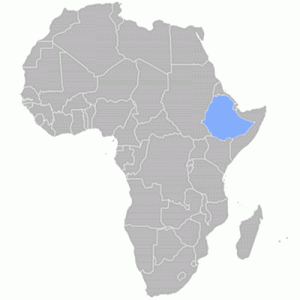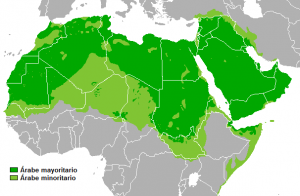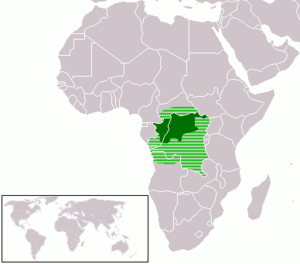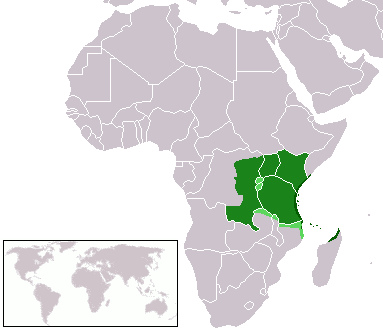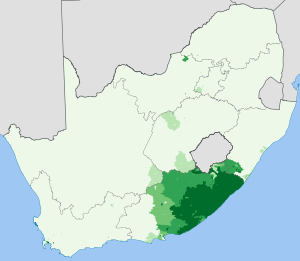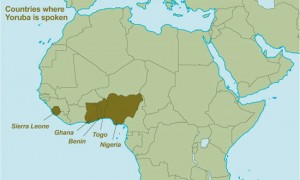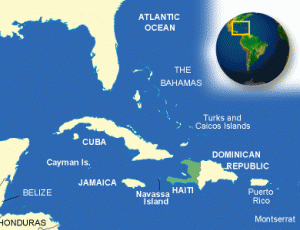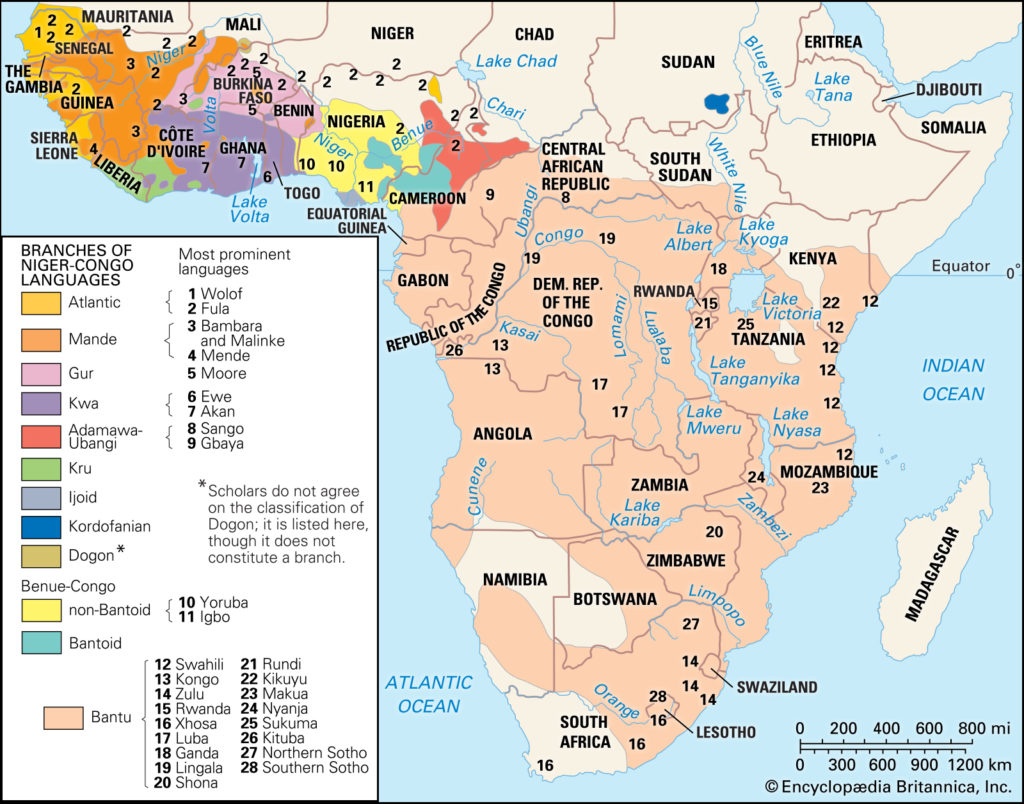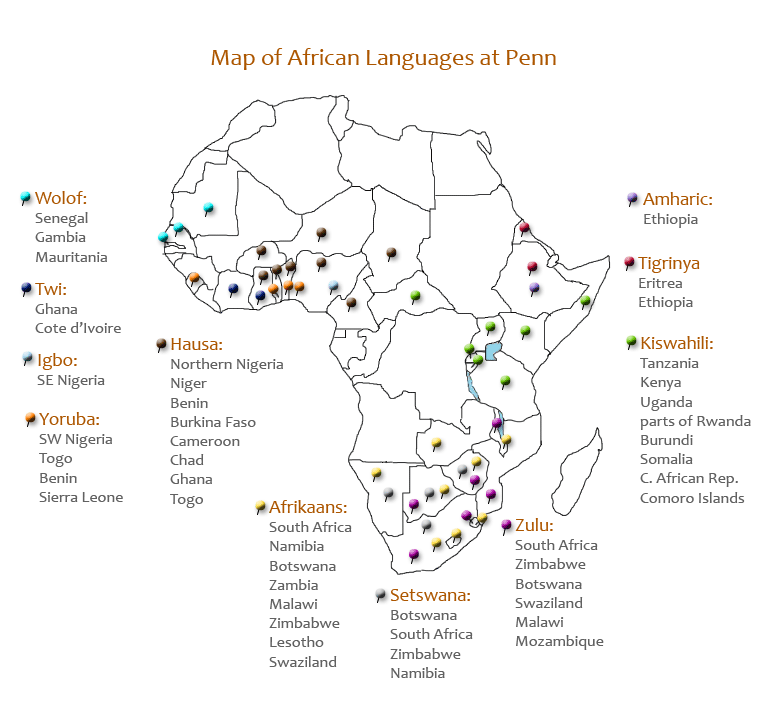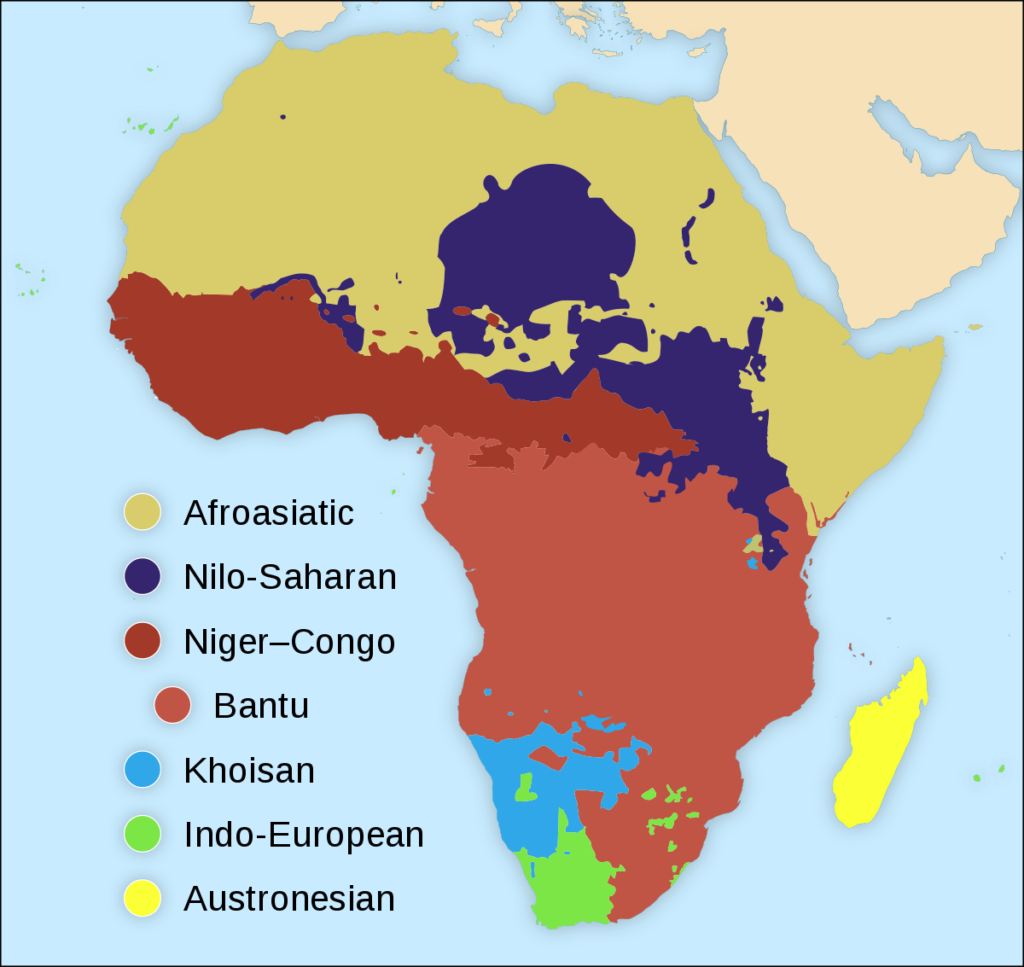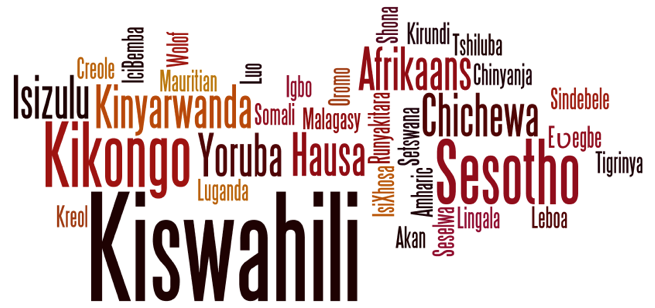
With more than 2,000 languages spoken throughout the continent, Africa is one of the most ethno-linguistically diverse areas on the planet. Language is significant to culture in Africa because language a central part of the human experience. Through language, people represent, interpret and organize reality. In this way, shared language facilitates the development of social ties between individuals and serves as the foundation for group cohesion because people who share a language also share norms, ideas and values about the world they live in. This lesson will address the cultural significance of language in Africa.
Lesson Objectives
- recognize the relationship between language and culture
- identify how systems of power are reflected in language
- describe the linguistic landscape in a selected African country
Language and Culture
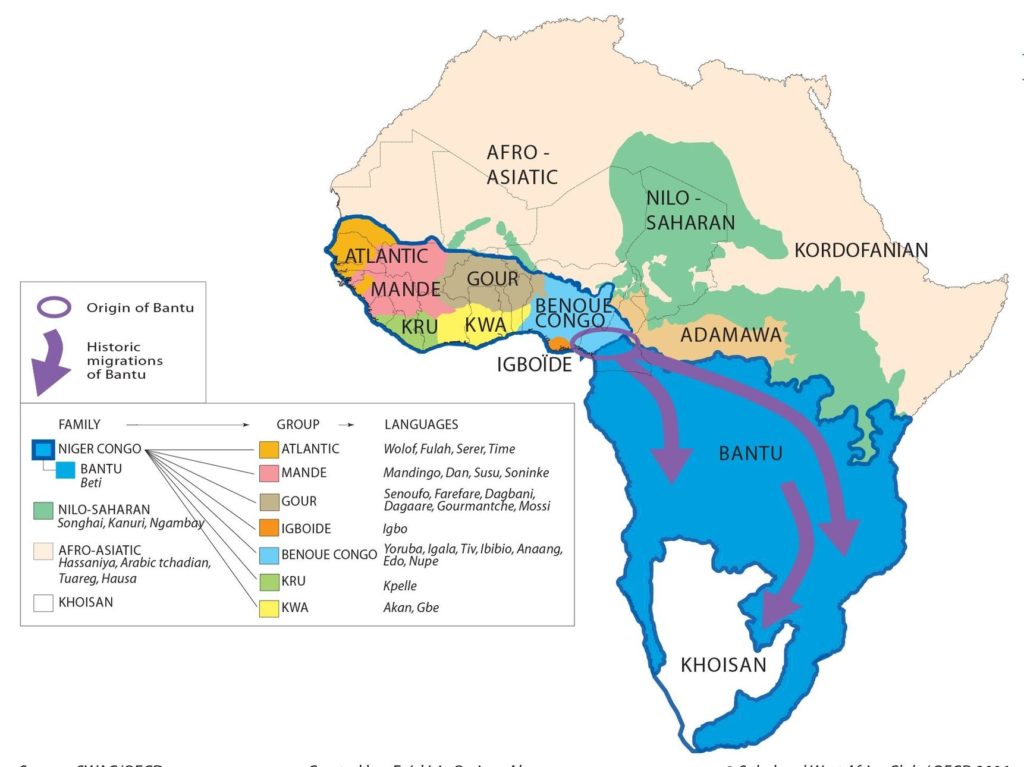
Language is acquired through socialization and interaction with others in a group. Since language is acquired through social interactions, it is embedded with social norms, values and ideas. An example of this is the use of the word ‘colored’ to describe people during the 20th century. The word communicates euro-centric values and hegemonic ideas that position light-skinned people as the standard, and those with darker skin as a deviation, having been ‘colored.’ Children who learn to use this word to describe people are also learning to evaluate, classify and reduce a wide range of diverse people according to skin color. The American Civil Rights movement and the African nationalist movements in the mid-twentieth century popularized different norms, values and ideas about identity that went far beyond skin color. New identity labels, or words, such as ‘African’, ‘African- American’ and ‘Afro-Carribean’, emphasize equality, cultural heritage, nationalism, and diversity (Asante 2007). Therefore, language both informs and is informed by society, culture and history. To learn more about the relationship between language and culture, watch the video below.
The link between language and culture is the reason why the survival of endangered African languages is key to the survival of African cultures.
Preserving Indigenous African Languages
The first module in this course highlighted rich diversity on the African continent; biological, environmental, cultural and linguistic. Africa hosts some of the most linguistically (and culturally) diverse places in the world. In post-colonial Africa however, former colonial languages such as French and English can provide greater economic and social advantages in African society because they remain the language of politics, power and wealth. As a result, many African languages are becoming endangered. The documentary below addresses the challenges faced by elder speakers of the n/u language facing extinction.
Today, a wide variety of government and educational programs aim to conserve African languages (and cultures) by promoting indigenous language learning in Africa as well as in educational institutions throughout the world. The University of Florida Center for African Studies is among the top African language learning institutions in the United States. Students at Santa Fe can register for UF courses to meet the foreign language requirement. the languages below represent a few of the languages taught at UF.
Akan
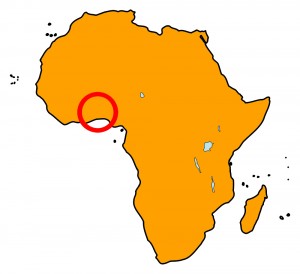
The Akan language is also known as Twi and Fante. It is the predominant indigenous language spoken in Ghana with about 80% of Ghana’s population speaking Akan. It is also spoken in Cote d’Ivoire, and among the descendants of enslaved people living in the interior of Suriname and the Maroons in Jamaica.
The Akan language has a rich literature in proverbs, folktales, and traditional drama, as well as a new literature in dramas, short stories, and novels. Joseph Hanson Kwabena Nketia collected a number of proverbs and folktales, including Funeral Dirges of the Akan People (1969), Folk Songs of Ghana (1963), and Akan Poetry (1958). Some of the important authors in the language are A. A. Opoku (dramatist), E. J. Osew (dramatist), K. E. Owusu (novelist), and R. A. Tabi (dramatist and novelist).
Important Words & Phrases
Akwaaba – Welcome
Ɛte sεn/Wo ho te sɛn? – How is it going/How are you?
meda wo ase – Thank you
Mepa wo kyew – Please/excuse me
Wo din de sεn? – What is your name?
Me din de … – My name is …
Amharic አማርኛ
Amharic is a Semitic language used in Ethiopia by the Amhara. It is the second most-spoken Semitic language in the world (after Arabic) and the official language of the Federal Democratic Republic of Ethiopia. It is also the official or working language of government, the military, and of the Ethiopian Orthodox Church. Amharic is spoken by nearly three million African emigrants throughout the world. Amharic is written left-to-right using a system that grew out of the Geʽez script. The writing system is called fidäl (ፊደል) in Ethiopian Semitic languages. Fidäl means “script”, “alphabet”, “letter”, or “character”. For more information about Amharic, review the NALRC Amharic brochure here and watch the Youtube video below.
Arabic لعربية
Arabic is a Semitic language that first emerged in the 1st to 4th centuries CE. It is widely spoken throughout Northern Africa and in some parts of Western and Eastern Africa. It is used in more than 22 countries and more than 280 million speakers worldwide making it the fifth most spoken language in the world. The literary language is called Modern Standard Arabic, and it is currently the only official form of Arabic in most written documents as well as in formal spoken occasions. Arabic is written with the Arabic alphabet, which is an abjad script and is written from right to left,
For more information, review the NALRC Arabic brochure here.
Lingala
Lingala is a Bantu language spoken by more than 10 million speakers throughout the Democratic Republic of the Congo (Congo-Kinshasa), the Republic of the Congo (Congo-Brazzaville), Angola and the Central African Republic. Lingala was used by Europeans to communicate with trade partners, and itw as referred to as “the trade language” or “the river language.” From 1884 onwards Eurpoeans referred to it as “Bangala” after Bangala Station. After 1901, Catholic missionaries proposed to rename the language “Lingala”, a proposition which took some decades to be generally accepted, both by colonials and the Congolese. This name change was accepted in western and northwestern Congo (as well as in other countries where the language was spoken), but not in northeastern Congo where the variety of the language spoken locally is still called Bangala. It has over 10 million speakers. For more information, review the NALRC Lingala brochure here.
Swahili سواحل
Swahili, also known as Kiswahili, is widely spoken throughout Eastern Africa from Kenya to Mozambique, as among some minority groups in Somalia. Swahili is an official, or national, language in Tanzania, Kenya, Uganda, the Comoros and the Democratic Republic of Congo (DRC). It is used as a lingua franca, or intercultural bridge language, through much of East Africa. Swahili has been greatly influenced by Arabic; there are an enormous number of Arabic loanwords in the language, including the word swahili, from Arabic sawāḥilī (a plural adjectival form of an Arabic word meaning “of the coast”). Some Swahili vocabulary also comes from Persian, German, Portuguese, English, and French. The exact number of Swahili speakers is unknown, and various estimates range from 50 million to 100 million.
For more information, review the NALRC Swahili brochure here, and watch the Zantel Business Solutions Commercial in Swahili below.
Wolof

Wolof is an indigenous language spoken in Senegal, The Gambia and Mauritania. It is spoken by more than 10 million people, and about 40 percent (approximately 5 million people) of Senegal’s population speak Wolof as their native language. Approximately three percent of the population speak Wolof as a first language in The Gambia as well as seven percent (185,000 people) of the population in Mauritania. Wolof dialects vary geographically and between rural and urban areas. “Dakar-Wolof”, for instance, is an urban mixture of Wolof, French, and Arabic. American English includes several Wolof words through the integration of enslaved African people such as; banana, chigger (insect), jazz, jive, jukebox, mojo (spirit), okra, voudo, cola, mumbo jumbo, and yam.
For more information about Wolof, review the NALRC Wolof brochure here, and watch the Music video, Baay Bia-Liy Am Amna in Wolof (with Subtitles) music video below.
Xhosa
Xhosais a language used by nearly eight million people throughout southern Africa. It is one of the official languages of South Africa and Zimbabwe. Xhosa is spoken as a first language by approximately 8.2 million people and by another 11 million as a second language in South Africa, mostly in Eastern Cape, Western Cape, Gauteng and Northern Cape. It was referred to as the ‘click language’ by European colonizers because approximately 10% of basic vocabulary contains a click sound. Xhosa-speaking peoples live along the coastal regions of southeastern Africa. Members of the ethnic group that speaks Xhosa refer to themselves as the amaXhosa and the language is called isiXhosa, or “Xhosa” in English. The broadcasts in Xhosa, and the famous performer of Xhosa songs, Miriam Makeba, popularized ‘Click Songs’ throughout the world.
For more information, review the NALRC Xhosa brochure here, and watch the Xhosa music video below.
Yoruba
Yorubais a Niger-Congo language spoken by nearly 20 million people throughout West Afria including Nigeria, Benin and Togo with with smaller migrated communities in Cote d’Ivoire, Sierra Leone and The Gambia as well as in communities throughout Europe and the Americas. It the most widely spoken African language outside of the continent. Literary Yoruba, also known as Standard Yoruba, Yoruba koiné, and common Yoruba, is the written form of the language learned at school and spoken by radio broadcasters. Yoruba also integrated Arabic words in predominantly Muslim areas. Like Wolof, American English includes Yoruba words, such as the word ‘fan’ which is derived from fani mora ‘to attract people to you.’
For more information, review the NALRC Yoruba brochure here, and watch the Indomie Instant Noodle Commercial in Yoruba below.
Haitian Creole
The Haitian Creole language is the predominant language spoken throughout Haiti. It is one of the official languages in Haiti, and is the primarily language in Haitian literature. The language is based on French, several African languages, Spanish, Taíno, Arawak and English. It is used by more than twelve million people living in Haiti and throughout the Caribbean as well as communities in Canada, the United States, Latin America, Africa and Europe. The Clean Compass Solar commercial below is in Haitian Creole.
Review the language maps in the gallery below and consider the spatial distribution of different languages and groups according to what you have already learned about phenomena such as colonialism, economics and the environment in Africa.
Language and Power in African Society
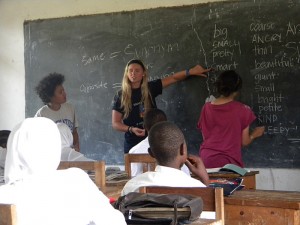
Socio-linguistics is the scientific study of the relationships between language variation and social contexts in the past and present (Romaine 2000; Trudgill 2000). Language change through time can also reflect historical changes, and linguistic similarities and differences can shed light on the historical relationships between different groups of people. While shared language can forge social bonds among people, language difference can divide people by excluding those who communicate differently. Research on linguistic variation has shown that social differences and hierarchies are expressed and reinforced by differences in the ways that people use language. In many ways, language can reinforce inequality by codifying differences in social status, class, ethnicity, race, gender, education and other forms of inequality (Lakoff 2000; Labov 1972a).
People also use and evaluate speech within social, political, and economic contexts (Kottak 2012). What this means is that people ascribe meanings to languages and the way languages are used according to different social, political and economic circumstances. In Morocco for example, many urban and educated mothers choose to speak to their children in French, the former colonial language rather than one of the indigenous Amazighe languages or even the predominant Arabic language (Sadiqi 2005). This is because French is symbolically associated with power; it was the language of the former colonial French government and it continues to be the primary language used in schools, government and urban cultural centers. Because of this, French is associated with modernity, and speaking French offers greater social, political and economic opportunities than the indigenous languages. Like many parents in post-colonial states, a large number of urban parents in Morocco choose to speak to their children in the language of the former colonial oppressor rather than the indigenous language spoken by their family’s social group.
Pierre Bourdieu (1982) refers to this linguistic hegemony as a type of symbolic domination, because even people who are not included in the dominant language social group oftentimes accept its authority and prestige. When the dominant language provides access to resources and opportunity, it becomes a type of symbolic capital because it can be used as leverage to acquire or increase wealth (Bourdieu 1984; Gal 1989; Lakoff 2000). This is particularly the case in areas where education and job opportunities are primarily conducted in former colonial languages such as French, English; people who are not familiar with the former colonial language are excluded from those opportunities.
Language Diversity and Loss
Of approximately 7,000 remaining languages, about 20% are currently endangered (Maugh 2007). As linguist K. David Harrison states, ‘When we lose a language, we lose centuries of thinking about time, seasons, sea creatures, reindeer, edible flowers, mathematics, landscape, myths, music, the unknown and the everyday.’ In his book, When Languages Die (2007), he notes that the world’s linguistic diversity has been cut in half since European colonial expansion was initiated 500 years ago. In the documentary trailer below, Helena Steenkamp, a San woman from the Kalahari Desert, South Africa embarks on a mission to revive the endangered N/uu language of her people. The cultural and spiritual journey battles time as the number of surviving elders diminish. Now, arriving at a pivotal juncture, the community must step in to support Helena’s mission before the younger generation loses the crux of their identity. For this small group that is determined to keep the N/uu language alive, they must struggle against the apathy of their community and government bureaucracy. As one of their leaders is acknowledged as Queen of the Khomani San, she asks if the dawn of her coronation will herald a new chapter in their struggle, and if it will be sufficient to ensure that neither their culture nor language is rendered extinct.
Bio-cultural Diversity in Africa
Africa is not only rich in linguistic diversity, it is also a hot spot for biological diversity. Research has also shown that there is a relationship between linguistic-cultural diversity and biological diversity. Areas with high language diversity are located in areas with high biodiversity, this is referred to as biocultural diversity. As we can see from the map below, Africa hosts some of the most bio-culturally diverse areas in the world. Language and culture are important to the environment because localized information about the environment is coded, or stored, in the words and meanings n the same way that information about culture is stored in a language. As a result, culture loss can impact the environment, and environmental destruction impacts language and cultural systems. We will explore this in greater detail in the Environment lesson.
African Language Study at Santa Fe College
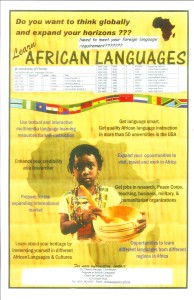
There are a wide range of opportunities for students to learn an African language while studying at Santa Fe. Through an agreement between Santa Fe and the University of Florida, SF students may enroll in UF foreign language courses that are not offered at Santa Fe. Enrollment is possible on a space-available basis. The Center for African Studies at the University of Florida (UFCAS) coordinates a diverse array of African language courses at UF during the spring and fall semesters as well as the African Language Institute during the summer. Visit the UFCAS language page here for more information.
For more information about opportunities for SF students to participate in African-language study at UF, visit the SF Transient Student Polices webpage to complete your request form. To inquire about open seats and/ specific language courses at UF, feel free to reach out to Dr. Sarah Cervone at Santa Fe College or contact Dr. Charles Bwenge (cbwenge@ufl.edu (352) 392-6232 or (352) 392-2183).
Questions to Consider
- How is an African language connected to African culture?
- In what ways does the linguistic landscape in Africa reflect a history of colonialism and post-colonial relationships?
- How does the linguistic landscape in your selected African country reflect power relationships in terms of rural and urban differences and/or linguistic patterns related to gender, age, etc.?
References and Resources:
- Kandybowicz, J., & Torrence, H. (Eds.) 2017. Africa’s Endangered Languages: Documentary and Theoretical Approaches. : Oxford University Press.
- Should African schools teach more local languages?
- Ethnologue: Countries & Languages
- Santa Fe African Language Study page
- National African Language Resource Center
- African Language Materials Archive:
- West African Linguistic Society
- African Languages.org
- Ethnologue: African Languages of the World
- UCLA Language Material Project
- Stanford University Language Resource Database
For Discussion in Canvas
Use the information and resources in this lesson to describe the linguistic landscape within your selected country. Include the indigenous and colonial languages as well as the estimated number of people (or percentage of the population) that use each language. What is/are the ‘official’ language(s) of education and government, and how does it affect the people who speak only one indigenous language? In what ways has economic or educational policies affected language use in the country? Do not forget to cite your sources and respond to other students’ posts to receive credit.
African Language Scholarship Extra Credit
There are a wide variety of scholarships, fellowships and grants to study an African language in the US and in Africa. To receive extra credit, select an African language program from the list below and apply for a scholarship to study an African language in the U.S. or in Africa. Post your application responses in the discussion (usually an essay) and include a screenshot of the submission confirmation. For assistance with the application process, feel free to contact Dr. Sarah Cervone in the Department of Humanities and Foreign Languages or the SF Office of International Education.
African Language Scholarship Opportunities
- Critical Language Scholarships (summer abroad, usually six to eight week programs)
- Scholarships.com
- Boren African Languages Initiative (study abroad, usually six to eight weeks)
- Middlebury Language School (top language school that offers summer study in Vermont)
- Foreign Language Area Studies (FLAS) at UF (for summer study and/or academic year study for UF transfer students)
- UF African Language Institute (Summer language program in Gainesville, scholarships available through FLAS and Boren)
- Benjamin A. Gilman Scholarship for study abroad in Africa

